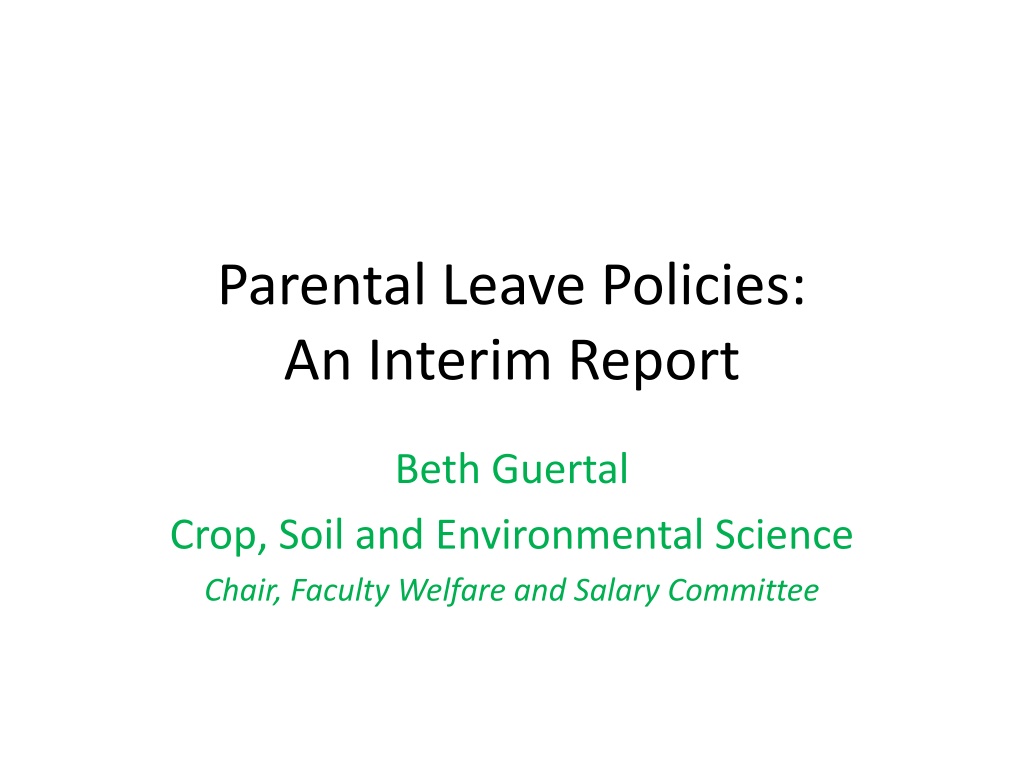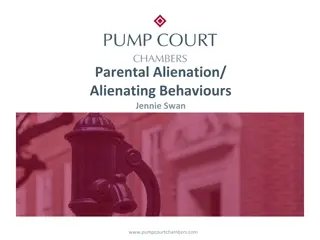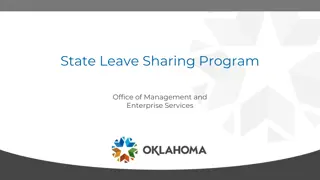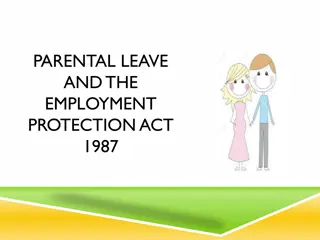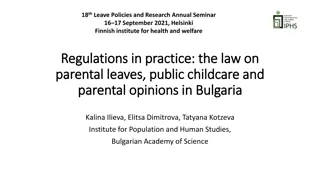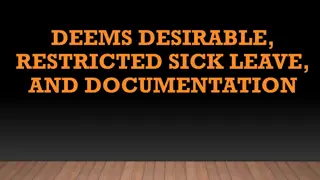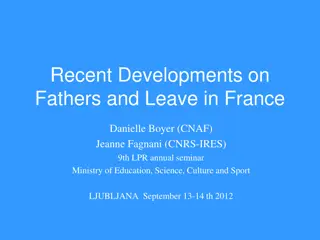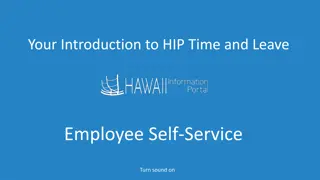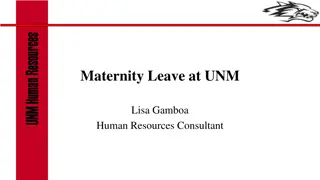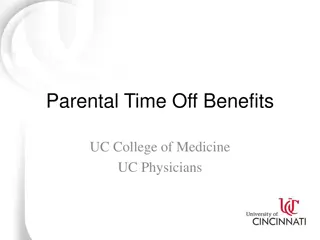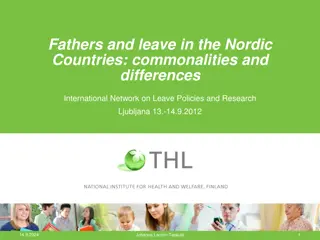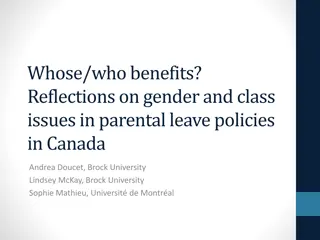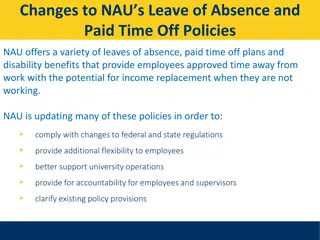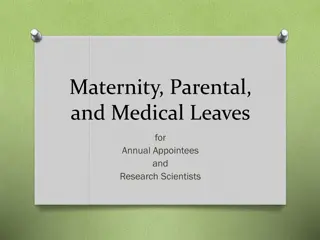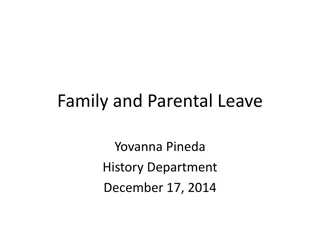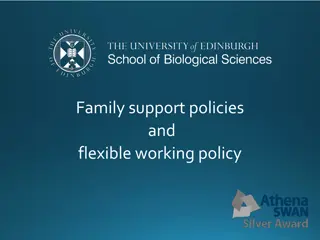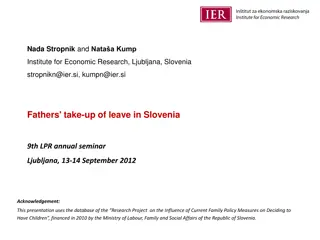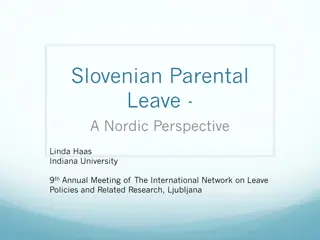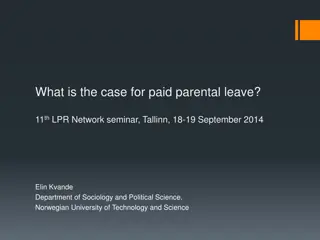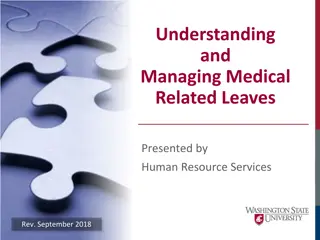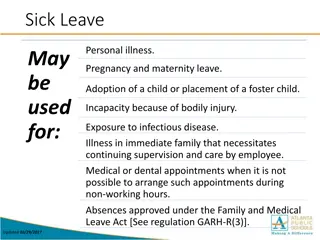Understanding Parental Leave Policies: An Overview
The Family and Medical Leave Act (FMLA) provides eligible employees with unpaid, job-protected leave for various family and medical reasons. FMLA allows for up to twelve workweeks of leave in a 12-month period for situations like the birth or adoption of a child, caring for a family member with a serious health condition, or qualifying exigencies for covered military members. Additionally, Auburn University offers a Salary Continuation Plan (SCP) as a short-term disability benefit, which includes salary protection for six months along with sick leave benefits. However, managing sick leave during SCP can be a challenge due to inconsistencies across departments. Understanding the application of sick leave and the interaction between FMLA and SCP is essential for employees navigating these policies.
Download Presentation

Please find below an Image/Link to download the presentation.
The content on the website is provided AS IS for your information and personal use only. It may not be sold, licensed, or shared on other websites without obtaining consent from the author. Download presentation by click this link. If you encounter any issues during the download, it is possible that the publisher has removed the file from their server.
E N D
Presentation Transcript
Parental Leave Policies: An Interim Report Beth Guertal Crop, Soil and Environmental Science Chair, Faculty Welfare and Salary Committee
Family and Medical Leave Act - Overview The FMLA entitles eligible employees of covered employers to take unpaid, job-protected leave for specified family and medical reasons with continuation of group health insurance coverage under the same terms and conditions as if the employee had not taken leave. Eligible employees are entitled to: Twelve workweeks of leave in a 12-month period for: the birth of a child and to care for the newborn child within one year of birth; the placement with the employee of a child for adoption or foster care and to care for the newly placed child within one year of placement; to care for the employee s spouse, child, or parent who has a serious health condition; a serious health condition that makes the employee unable to perform the essential functions of his or her job; any qualifying exigency arising out of the fact that the employee s spouse, son, daughter, or parent is a covered military member on covered active duty;
The Nitty Gritty FMLA can be taken intermittently, but a doctor must document this need. FMLA is managed by HR, is required by law and is unpaid. FMLA protects the job, not the right to get paid while not working in the job. Once FMLA is exhausted job protection ends.
What Auburn Offers SCP Salary Continuation Plan - a short term disability benefit. This is managed internally. Requires medical certification. It has been Auburn s practice to protect jobs for the 6 months of SCP (but it is not a guarantee). No stated limit for how many times or how often a person may apply for SCP. SCP is two parts: Use sick leave at 100% pay. SCP at 60% of pay. It is a total sick leave + SCP = 6 months
FMLA and SCP 1. Complete the FMLA forms doctor etc. 2. Go on sick leave (can use annual leave but do not have to do so) 3. Once sick leave is exhausted - file the Salary Compensation Program (SCP) paperwork. 4. SCP then provides 60% of salary for up to 6 months. 5. One is on FMLA whilst receiving SCP, but FMLA lasts only 12 weeks, while SCP can last up to 6 months. 6. Sick Leave + SCP cannot exceed 6 months. It s not additive.
Issue 1 The application and use of sick leave during the early parts of SCP. Everyone (who is eligible) accrues sick leave as if they work a 40 hour week, or 5 eight hour days. Some departments only make faculty take sick leave for hours in which they teach basically, we have inconsistencies in use of sick leave.
Issue 2. What Happens after 6 Months? SCP ends after 6 months what happens next lacks consistency. Departments need to work with HR on this issue. If the person is left as actively employed it causes issues with benefits. If not considered as continued leave they are not eligible for COBRA insurance or continued benefits. Basically Limbo if they die or go on LTD they lose access to coverage life insurance, health insurance, disability.
Flow Chart Obtain and fill out FMLA and SCP forms both require doctors signature. Go on sick leave Have the FMLA and SCP forms ready if needed. Pregnant ----- > ----- > ----- > Switch to FMLA and SCP both run simultaneously. Sick leave is exhausted. Either annual leave is exhausted or you choose not to use it. Up to six months of 60% salary via SCP. ----- > ----- > Non-child bearing spouse or adoptive parents start here. Do not have to use sick or annual leave.
Comparisons School Does your University offer any type of parental/adoptive leave in addition to FML? If so, how long? Alabama Maternity leave for 9 month faculty without sick or annual leave. Up to 6 weeks, if baby not born in summer. Univ. S. AL NO Tennessee NO UGA NO Missouri NO Kentucky NO Nebraska YES 8 weeks all deducted from accrued sick/vacation leave Indiana YES up to one year
Comparisons School Does your University offer any type of parental/adoptive leave in addition to FML? If so, how long? Purdue YES Illinois YES 2 weeks paid parental leave NCSU NO (No sick leave for 9 mo. faculty) Oklahoma State NO Texas A & M NO Florida YES up to 6 months but appears to simply be vacation/sick leave LSU NO
University of Florida Employees in leave-accruing positions may request up to 6 weeks of advanced sick or vacation leave for the birth or adoption of a child or the initial placement of a child in the foster care of the employee. Employees may also use their personal accrued leave, unpaid leave, or a combination of paid and unpaid leave, so long as the total parental leave period, including the paid parental leave program, does not exceed a total of six (6) calendar months from the first date leave is used. If being used for foster care, the paid parental leave must be used within the FMLA entitlement period of twelve (12) workweeks.
Illinois Parental Leave Length of Leave Eligible employees are granted up to two weeks of leave with pay for parental leave. Parental leave is limited to one leave per twelve-month academic appointment year. For eligible employees, parental leave taken will count toward the 12-week FMLA entitlement. Parental leave following the birth of a child must be taken in full immediately after the birth or immediately following the child's release from a health care facility to the home. Parental leave for an adopted child may be taken in full either at the time of initial placement or at the time of legal adoption. Leave cannot be taken on an intermittent schedule, or on a reduced leave schedule for a period lasting longer than two weeks.
Indiana Family leave provides eligible academic appointees with up to twelve weeks of fully paid leave. For the birth or adoption of a child by the academic appointee or the academic appointee s spouse or domestic partner, or the primary care of an eligible family member with a serious health condition. Both 10- and 12-month academic appointees are eligible for family leave after two years of continuous full-time Indiana University service. Visiting, adjunct, part-time, post-doctoral, and intermittent appointees are not eligible for family leave. Academic appointees may take family leave up to twice every five years, but the appointee must return to full-time service for at least one fall or spring semester between leaves. Appointees in non-teaching appointments must return for at least five months.
Purdue It is the policy of Purdue University to provide Paid Parental Leave to benefits-eligible employees, including graduate student employees, due to the birth of an employee's child or the placement within an employee's home of an adopted child. This policy will run concurrently with Family and Medical Leave Act (FMLA) leave, in cases where an employee is eligible for FMLA leave. This policy is in effect for childbirth or adoptions occurring on or after October 1, 2008.
Purdue Word Definition Eligible Employee An employee who has been employed by the University for at least one continuous year (12 months) half-time or more in a benefits- eligible faculty or staff position, a graduate student employee position, or a benefits-eligible post-doc position. The Family and Medical Leave Act of 1993, 29 U.S.C. 2611 et. seq. Family and Medical Leave Act or FMLA Parent A male or female faculty or staff member, graduate student employee, or post-doc who is a birth mother; a father of the birth child; a same-sex domestic partner of the birth mother; a same-sex domestic partner of the birth father; an adoptive mother or father; a same-sex domestic partner of an adoptive mother or father. A period of paid leave of absence (that does not reduce an Eligible Employee's balance of any other paid leave such as sick, vacation, or personal business days or personal holiday) for the purpose of recovery from the birth of a child; and/or, to bond with a newborn or with a newly-adopted child under the age of 18. Paid Parental Leave 240 hours total for paid leave
Summary Of our snapshot survey, very few schools offer parental benefits beyond FMLA and use of an individual s accrued sick and/or vacation leave. Additional paid parental leave may be offered for a short period 2 weeks. Typically for all faculty, regardless of appointment (eg: 12, 10 , 9 mo.). Some other requirements as well (must have been employed for one year, etc.). Other University staff are typically included, but often not post-docs or graduate students.
Thanks to the Committee Barbara Wilder, Nursing 2014 Douglas Rosener, Music 2014 Yolanda Brady, Agriculture 2015 Jennifer Mueller, Accounting, COB 2015 Lindsay Walker, Liberal Arts 2015 Ivan Watts, Education 2015 William Kelly, Political Science 2016 Karla McCormick, Payroll & Employee Benefits Continuing Joel Hunter 2014 Jayne Kucera 2016
